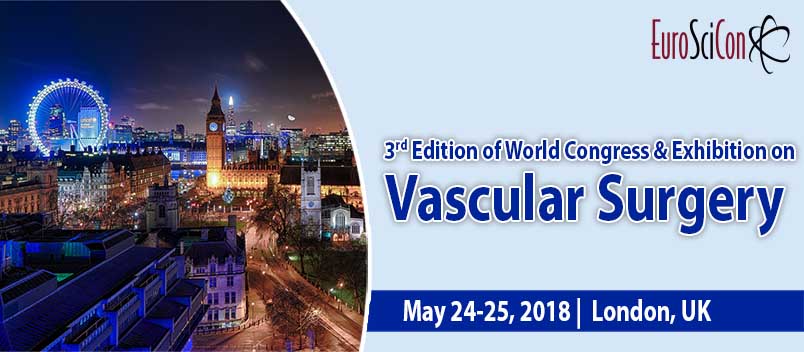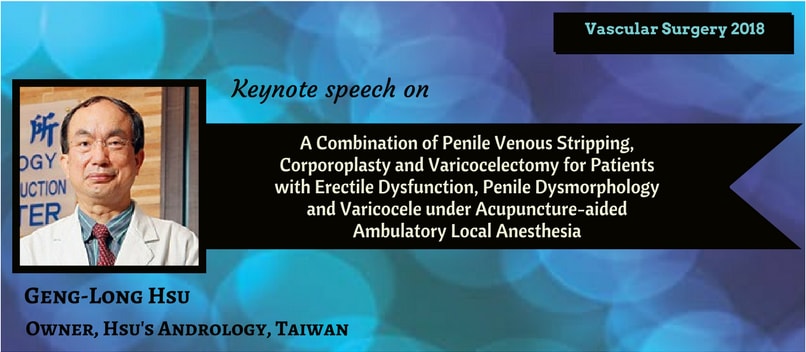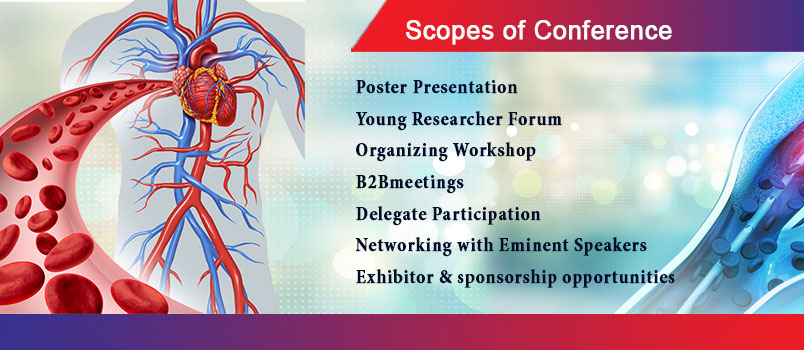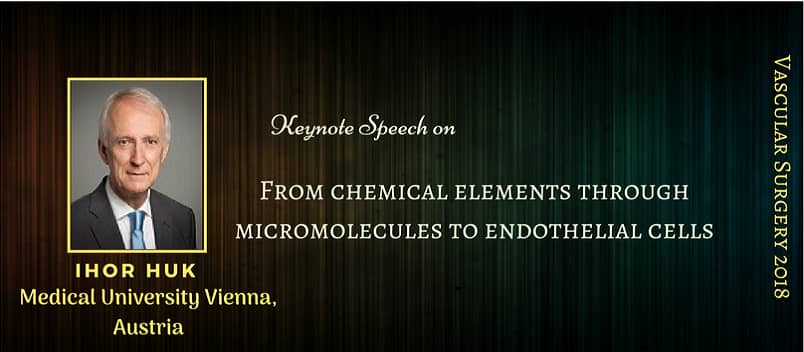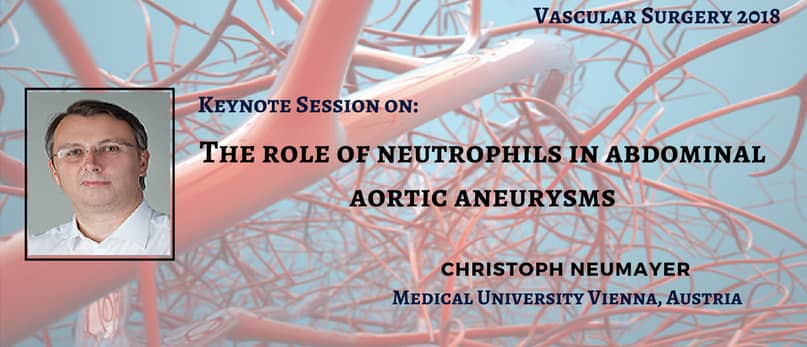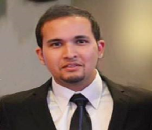Vascular Surgery 2018
About Conference
Euroscicon Ltd with immense pleasure invites all the contributors across the globe to the 3rd Edition of World Congress & Exhibition on Vascular Surgery (Vascular Surgery 2018) during May 24-25, 2018 at London, UK which includes prompt keynote presentations, Oral talks, Poster presentations and Exhibitions. Euroscicon Ltd organizes 1000+ scientific events inclusive of 600+ Conferences, 500+ Workshops and 200+ Symposiums on various topics of Science & Technology across the globe with support from 1000 more scientific societies and Publishes 500+ Open Access journals which contains over 50000 eminent personalities, reputed scientists as editorial board members.
Vascular surgery deals with the diagnosis and sub-surgical procedures for the management and treatment of disorders/diseases related to the vascular system, i.e. veins, arteries and the lymphatic system, excluding the coronary and intracranial arteries. A vascular surgeon is concerned with treating the blood vessels of the body including arms, legs, organs and other tissues of the body, except that of heart and brain. Vascular surgery is advised when a vascular disease cannot be treated by less invasive or non-surgical methods. The purpose of vascular surgery is to treat those diseases related to veins and arteries known as arterial and venous diseases.
Vascular diseases are caused due to the conditions like clotting of blood in blood vessels, weaken blood vessels or damaged valves which control the flow of blood within the veins thus depriving of vital nutrients and oxygen. Common vascular diseases are atherosclerosis, aortic aneurysms, peripheral vascular disease, carotid artery disease. Surgery is often suggested to treat such diseases to aid prevent strokes or heart attacks, relieve angina or hypertension, eradicate aneurysms, improve claudication by repairing the arteries, bypassing, or replacing them. Atherosclerosis i.e., the hardening of arteries occurs as people age due to the accumulation of fatty material containing cholesterol or calcium on the innermost layer of artery; cause the narrowing of the inside diameter of the blood vessels. Gradually, the blood vessels become so narrow that blot clots (thrombus) forms which blocks the blood flow to the entire portion of the body; creating the condition known as PVD or peripheral arterial disease. In another form of atherosclerosis, ulcer forms at the diseased interior of the blood vessels where blood clots tend to form. These blood clots then break the ulcer and blocks the arteries in the narrower ends.
Vascular surgery involves techniques relating to endovascular surgeries such as balloon angioplasty with or without stenting, aortic and peripheral vascular graft replacement, thrombolytic therapy, and other aides for vascular reconstructions.
Session/ Tracks
Track 1: Vascular Trauma
The term ‘vascular trauma’ refers to damage or injury to a blood vessel- an artery, which carries blood away from the heart, or a vein, which carry blood back to the heart from different organs. These injuries are categorized by the type of trauma that cause them: blunt or penetrating injury.
• Blunt injury can occur if a blood vessel is crushed or stretched.
• penetrating injury can occur if a blood vessel is punctured, torn or severed.
Both the types of vascular trauma can cause the blood vessel to clot (thrombosis) and interrupt blood flow to an organ, or cause bleeding, leading to life-threatening hemorrhage.
Vascular trauma results from a wide range of causes:
Injury (accidents, falls, cuts, etc.)
Violence
Pinching of a vein or artery
Dislocation of a bone
Piercing of a vein, such as with insertion of an IV.
Vascular injury has two main consequences- hemorrhage and ischemia. Unrecognized and uncontrolled hemorrhage can lead to demise of the trauma patient while unrecognized and untreated ischemia can lead to stroke, limb loss, bowel necrosis and multiple organ failure.
Track 2: Venous Surgery
Chronic Venous Insufficiency and Varicose veins are the most frequent blood vessel abnormalities occurring in people and affects approximately one third of the population. The treatment of these disorders depends on many factors. Mild and moderate symptoms can be successfully treated with the use of compression stocking therapy but for severe symptoms medical surgeries are done either to remove varicose veins or to close them which includes: Vein stripping, Vein ablation, Sclerotherapy, Laser Surgery, Endoscopic Vein Surgery, Ambulatory Phlebectomy.
Track 3: Vascular Diseases of the Lower Limbs
Vascular diseases of the lower limb include: Peripheral Arterial disease of the legs and Chronic Arterial Insufficiency of the lower extremities. PAD is the condition of blood vessels that supply the legs and feet. It includes the narrowing and hardening of the arteries that results in decreased blood flow, which can injure nerve and other tissues. This problem occurs due to the buildup of fatty material (plaque) on the inside wall of arteries. Plaque is made up of extra cholesterol, calcium in blood. Blood carries the oxygen to the lower extremities but plaque buildup starves the tissues and muscles in lower limb. The underlying mechanism is usually atherosclerosis. The main risk factors include cigarette smoking, diabetes, high blood cholesterol and high blood pressure.
Track 4: Carotid Artery Disease
The carotid arteries are the blood vessels (coronary arteries) that carry oxygenated blood to the head, brain and face. They are located on each side of the neck. These arteries supply oxygen-rich blood to the large front part of the brain which control thought, personality, speech, as well as our sensory and motor functions. Carotid Artery disease occurs due to the narrowing of these arteries mostly due to atherosclerosis (plaque buildup). These plaques may break and block smaller arteries in the brain. The arteries are the source of oxygenated blood to the brain but this blockage interrupts the blood flow thus increasing the risk of stroke. A stroke can cause lasting brain damage, long-term disability, such as vision, speech problems or paralysis; or death.
Track 5: Vascular Disease of Upper Limb
Upper extremity vascular disease is relatively uncommon compared to lower extremity vascular disease but represents a unique diagnostic challenge for the physicians. The most common causes of upper extremity vascular disease are atherosclerosis and Embolic disease, but there are other systemic diseases and anatomic abnormalities such as vasculitis, arteritis, Takayasu’s Arteritis, Thoracic Outlet Compression Syndrome, Acute occlusive arterial disease and Aneurysm of upper limb artery. Some of the typical symptoms of upper extremity vascular disease include: discomfort or pain in arms, tightness, heaviness, weakness or cramping in one or both arms.
Track 6: Abdominal Aortic Aneurysms
An Abdominal Aortic Aneurism (AAA) is an enlarged area in the lower part of the aorta- the major blood vessel that supplies blood from the heart up to head and arms and down to abdomen, legs and pelvis. As aorta is the body’s main supplier of blood, a ruptured abdominal aortic aneurysm can cause life threatening bleeding. Large aneurysms are rare but are usually fetal. The bulging occurs when the walls of the aorta weakens. The reason of weakness is thought to be smoking, high blood pressure, high cholesterol level. Rupture of the abdominal aorta may result in pain in the abdomen, low blood pressure or loss of consciousness and often results in death. AAA most commonly occurs in men over 50 years of age and among those with a family history. Surgery is normally recommended with enlarged AAA, and repair may be either by open surgery or Endovascular Aneurysm Repair (EVAR).
Track 7: Thoracic Aortic Vascular Surgery
Thoracic Aortic Aneurysm is an expansion or ballooning of a section of aorta within the chest (thorax) that slowly degenerates. Thoracic Aortic Aneurysms are rare, occurring in approximately 6-10 per every 100,000 people. Surgery is often suggested if the risk of rupture is higher. The procedure for Thoracic Aortic Vascular Surgery is called Thoracic Endovascular Aortic Repair (TEVAR). To fix the aorta, a device made of a fabric- covered metal mesh known as stent graft is inserted through a small hole. The device repairs the diseased aorta, helps to keep it open and allows blood to flow easily to rest of the body. The alternative to TEVAR is refer to as ‘open repair’, which requires a large incision through the breastbone or side of the chest.
Track 8: Thoracoabdominal Aortic Vascular Surgery
Thoracoabdominal Aortic Aneurysm (TAAA) refers to the abnormal widening of the aorta involving both the thoracic and abdominal segments. These aneurysms are primarily the results of age related degeneration and weakening of the aortic wall. Elective surgical interventions are considered when the aortic size exceeds 5-6 cm. There are three surgical operative techniques for TAAA repair: open, endovascular and hybrid.
Open TAAA repair involves surgical removal of the diseased section of the aorta and replacing it with an artificial graft by making an incision extending from the upper back on the left side, curving around under the shoulder blade around to the front of abdomen.
Endovascular approach includes much less invasion with small incisions to access the blood vessels in the groin. A catheter is inserted and is used to deploy a stent graft within the aneurysm.
Hybrid approach uses a combination of the two techniques.
Track 9: Surgery for Veins and Lymphatic Diseases
Thrombolytic therapy, surgical thrombectomy, and placement of inferior vena cava filters are adjunctive treatments that can be suggested for patients with extensive and complicated venous thromboembolism. For patients with saphenous vein valvular insufficiency vein stripping, endovenous laser treatment and radiofrequency ablation therapies are implemented. Concomitant varicose veins may be managed with compression therapy, sclerotherapy and phlebectomy.
Track 10: Vascular Imaging
Vascular imaging is a test that enables to access and evaluate the body’s circulatory system and help identify blockages in veins and arteries and detect blood clots. Non-optical methods that are widely used for vascular images includes X-ray/CT, MRI, ultrasound and positron emission tomography. These techniques are most popularly used for macrovascular imaging but due to poor spatial contrast these are not effective for microvascular imaging. Optical methods recommended for microvascular imaging are single-photon fluorescence microscopy (1PFM), two-photon fluorescence microscopy, orthogonal polarization spectral imaging (OCSI), laser speckle contrast imaging (LSCI), diffusive imaging, diffuse optical tomography, etc.
Track 11: Vascular Malformations
Vascular malformations are abnormal clusters of blood vessels that occur during fetal development. These malformations are thought to result from developmental errors during embryogenesis such as abnormal signaling processes that control apoptosis, maturation and growth of vascular cells. Although these kinds of lesions are present at birth, they may not be visible until weeks or several years but typically grow in proportion to the growth of the child. Vascular malformations are characterized under four types based on their flow characteristics: slow flow (capillary malformations, venous malformation, lymphatic malformation) and fast-flow (arteriovenous malformation). Proper identification and multidisciplinary approach is paramount for proper treatment.
Track 12: Acute Limb Ischaemia
Acute limb ischaemia is defined as a sudden decrease in limb perfusion that results in potential threat to the viability of the limb. It results from a sudden obstruction in the arterial flow mainly due to embolism or thrombosis and rarely by dissection or trauma. The occurrence of this case is almost 1.5 cases per 10,000 persons per year. Symptoms begins over a period of hours or days from new or worsening intermittent claudication to pain in foot or leg, muscle weakness, and paralysis of the affected limb. The rapid onset of limb ischemia results from sudden blockage of blood supply and nutrients to tissues and nerves of the limb; threatening limb viability due to insufficient time for new blood vessel growth to compensate for loss of perfusion. The primary intervention for acute limb ischemia is emergency embolectomy or vascular bypass to route the blood flow.
Track 13: Renovascular Surgery
Renal artery is the vessel through which blood passes to the kidney to remove the body’s waste. These renal arteries originate in the heart and are also responsible for carrying oxygenated blood to the kidneys. Like other arteries the renal arteries also become blocked, the condition which is called renal artery stenosis. These arteries are affected due to several diseases such as atherosclerosis, renal artery aneurysm, fibromuscular dysplasia and vasculitis. Decreased blood flow to the kidneys often lead to hypertension. If untreated, renovascular hypertension may lead to cardiovascular and kidney problems. Treatments for renovascular hypertension refer to restore the normal blood flow to the kidney. This may be done by balloon angioplasty, use of stent to keep the artery open. Surgical technique in case of atherosclerosis include endarterectomy or bypass grafting.
Track 14: Mesenteric Ischemia
Mesenteric Ischemia is a condition caused by poor blood supply to the small intestine, colon or both and eventually results in gangrene of the bowel wall. It may also affect other organs in the digestive system. Due to poor circulation blockages may form that compromises the function of those organs. Mesenteric ischemia has both acute and chronic forms. Acute ischemia seeks a surgical emergency. It is associated with both embolic and thrombotic occlusions. 40-50% of the cases are related to embolic occlusions whereas 20-35% of the cases are due to thrombotic occlusions. Mesenteric ischemia is rare but is potentially a life-threatening condition. Treatment is by embolectomy, revascularization of viable segment or resection and sometimes vasodilator therapy is successful.
Track 15: Congenital Diseases of Vasculature
Congenital vascular anomalies are rare. Congenital vascular anomalies occur in barely 1% of all births. These are the vascular malformations or vascular tumors i.e., abnormally formed blood vessels present by birth. Congenital vascular diseases include vascular malformations and vascular tumor known as hemangioma; both of which are commonly called “birthmarks”. Most of these birth marks represent vascular malformation, consisting of abnormal collection of small blood vessels near the skin. Normally vascular malformations are not a health threat as they grow proportionately with the growth of the child. But hemangioma may be alarming during their growth phase called the ‘juvenile hemangiomas’ and requires immediate treatment.
Track 16: Lymphedema
Lymphedema, or lymphatic obstruction, is a long-term condition where excess fluid collects in tissues causing swelling (edema). The main symptom is swelling in arm, or leg that may be accompanied by pain or discomfort. Lymph is a clear, thin fluid that circulates throughout the body to remove wastes, bacteria, and other substances from tissues. Edema is the buildup of excess fluids. So, lymphedema occurs when too much lymph gets collected in an area. The cause of lymphedema is generally cancer treatment where one or two lymph nodes are removed. Normally lymph nodes filter fluids that flow through them, so without normal lymph drainage, fluid can build up in the affected arm or leg and lymphedema develops. Lymphedema can also be present by birth or can develop during puberty.
Track 17: Venous Insufficiency
Venous insufficiency is a condition where the flow of blood in the veins is inadequate, which causes blood to pool in the legs. In these states valve in the veins don’t work and venous blood refluxes backward down the veins into an already congested leg. Chronic venous insufficiency is a long-term condition. It is commonly due to malfunctioning (incompetent) valves in the veins. It may also result from the blood clot in the veins. Usually it is treated by compression stockings, exercise and weight loss, but in some cases, require vein ablation or vein stripping.
Track 18: Vascular Bypass Grafting
Bypass grafting is a surgical procedure to redirect blood flow from one area to another in an area of blockage by reconnecting vessels. It is performed due to ischemia (inadequate blood flow) caused by atherosclerosis or other vascular diseases. In this procedure, an alternate channel is created for blood flow by replacing a damaged vessel. The graft is generally taken from one’s own healthy region (autograft), or a graft material such as Teflon or Dacron. The lifespan of a surgical bypass depends on the health of the arteries, the type of graft used- natural vein graft last longer than synthetic ones.
Track 19: Techniques of Open Vascular Surgery
Some of the open vascular surgeries are:
Arterial graft- it is performed to bypass a diseased or blocked part of an artery in order to restore proper blood flow and reduce the risk of complications. The graft is taken from healthy part of the body such as arms or legs.
Carotid endarterectomy- it begins with an incision in the neck, exposing the narrowed carotid artery where the surgeon opens the artery to remove the plaque.
Surgical aneurysm repair- aneurysm is an abnormal bulge in the wall of an artery, they are extremely risky: if they burst it can lead to life threatening internal hemorrhage. Open aneurysm repair includes replacement of weakened part of the artery with a tube-like structure.
Abdominal aortic aneurysm surgery- It involves the incision to open the abdomen, removing the aneurysm and replacement of the excised portion with synthetic tube.
Track 20: Anesthesia for Vascular Surgery
A vascular surgical procedure can be performed under local, regional or a general anesthesia, or a combination of these techniques based upon the complexity of the vascular pathology. Anesthesia is a risk factor which contributes to perioperative morbidity and mortality of vascular patients. Minimally invasive approaches to vascular surgery are developing gradually allowing the use of more localized anesthesia. It is often supposed that undergoing a procedure with local or regional anesthesia results in lower mortality and morbidity and results in earlier recovery.
Track 21: Lower Limb Amputations
Lower limb amputation in relation to vasculature means the surgical removal of leg or foot from the body as a result of peripheral vascular diseases. It is a life-saving procedure done to remove ischemic, infected, or necrotic tissue. Peripheral arterial diseases alone or in combination with diabetes mellitus contributes to more than half of the amputations. Major amputations are due to PAD ranging from 12 to 50 per 100,000 individuals per year.
Track 22: Endovascular Surgery
Endovascular surgery is used to treat vascular diseases from inside the blood vessels. A small incision is created to gain access to the diseased area (veins and arteries) inside the body. This technique results in less pain and faster recovery. These are the minimally invasive techniques to repair vascular aneurysms with the help of intravascular sheaths, wires, catheters, balloons, stents and stent grafts. The most common and advanced form of endovascular surgery going on today is an endovascular repair of aortic aneurysms and dissections by use of stent grafts inserted into vasculature via arteries in the groin.
Market Analysis
The global market for peripheral surgical instruments reached $5.8 billion in 2012. This market is supposed to grow from %6.2 billion in 2013 to $8.4 billion in 2018 with a compound annual growth rate (CAGR) of 6.3% for the five-year period of 2013-2018 due to increased demand for minimally invasive endovascular procedures, higher availability of improved solutions for artery revascularization and the rising pervasiveness of peripheral artery disease (PAD). According to research, the global market for peripheral vascular interventions, including lower extremity stents, percutaneous transluminal angioplasty (PTA) balloons, PTA drug-eluting balloons (DEB), carotid stents and renal stents will rise from $2.1 billion in 2015 to $3.4 billion by 2022. The launch of these advanced products such as DEBs has resulted in the growing demand for non-stent treatments like PAD and those in which stents cannot be used. Prevalence of PAD is increasing throughout the World due to the increase in high risk factors such as hypertension, diabetes, stroke, obesity resulting in greater demand for vascular surgery minimally invasive instruments. An increasing number of physicians and doctors trained in endovascular techniques will help to discourse this.
The current players within the large and dynamic peripheral interventions market are:
Abbott Vascular, Boston Scientific, C.R. Bard, Cook Medical, Cordis, Medtronic, W.L. Gore, Biotronik, B. Braun, Maquet, Life systems Medical and Eurocor.
Large databases has also been of rich source of clinical and administrative information on broad populations. These datasets have been characterized by clinical and demographic data for over 1000 pateints from multiple institutions and hospitals. Several important studies have been published in vascular care using large databases. However, previous literature demonstrated that results from randomized controlled trials occur to support the main treatment interventions for just 24% of vascular surgical patients. In most of the situations observational study serves an important role in guiding clinical decision-making. So, such large databases have been used in higher frequency for clinical research in vascular surgery. The Nationwide Inpatient Sample (NIS), is the largest all-payer inpatient care, publicly available database in United States representing 5 -8 million hospitals stays from 1000 hospitals. The national in-hospital mortality of many vascular surgical procedures has also been based upon the data from NIS which includes endovascular aneurysm repair (EVAR), renal artery bypass grafting for ruptured infrarenal abdominal aneurysms. NIS has also allowed the study of many vascular surgical procedures such as repair of decending thoracic aneurysm, elective abdominal aortic aneurysms, carotid endarterectomy and lower extremity bypass. Vascular Surgery centers in Maine, New Hampshire, Massachusetts and Vermont shared outcomes data to form the Vascular Study Group of Northern New England (VSGNNE). VSGNNE collects data on five surgical procedures of carotid endarterectomy, open and endovascular abdominal aortic aneurysm repairs, carotid artery stenting and lower extremity bypass.
Learn More
Top Vascular Surgery based Universities Worldwide
Vascular Surgery based Universities in Europe
UNIVERSITY OF GOTHENBURG | Heidelberg University Hospital | Medical University of Lublin | Semmelweis University | The University of Sydney | University Hospital Basel | The University of Oklahoma-Tulsa | Macquarie University | Stony Brook School of Medicine | McGovern Medical School | Yale University | Lithuanian University of Health Sciences | Yerevan State Medical University | St. Theresa Medical University of Yerevan | University of Medicine, Tirana | Medical University of Innsbruck | Karl Landsteiner University of Health Sciences | Johannes Kepler University Linz | Medical University of Graz | Medical University of Vienna | Paracelsus Medical University | Wroclaw Medical University | Medical University of Silesia | Bogomolates National Medical University | University of Cambridge | Imperial College Scholl of Medicine | Brighton and Sussex Medical School | University of Zagreb | King’s College London | Swansea University Medical School | University of Edinburg Medical School | Bristol Medical School | Lancaster Medical School | Liverpool Medical School | Newcastle University Medical School | UCL Medical School | Queen's University Belfast Medical School
Vascular Surgery Universities in Asia
The University of Tokyo | National University of Singapore (NUS) | Kyoto University | Peking University | Seoul National University (SNU) | National Taiwan University (NTU) | Osaka University | Taipei Medical University | Yonsei University | Tokyo Medical and Dental University | Sungkyunkwan University | Zhejiang University | Indian Institute of Science |Universiti Kebangsaan Malaysia (UKM) | National Yang Ming University | Hanyang University | Beijing Institute of Technology | Vietnam National University, Hanoi | Australian National University Medical School | Sydney Medical School | University of New South Wales Faculty of Medicine | University of Wollongong | University of Notre Dame | Bond University | Griffith University | James Cook University | University of Queensland | University of Adelaide | Flinders University | University of Tasmania | Melbourne Medical School | Monash University | Deakin University |
Vascular Surgery Universities in USA
Emory University School of Medicine | Mayo Medical School | Maryland School of Medicine | University of Cincinnati Academic Health Center | Georgetown School of Medicine | Utah School of Medicine | Vermont College of Medicine | UMASS School of Medicine | Texas A&M Health Science Center | Charles R. Drew University of Medicine and Science | Johns Hopkins University in Baltimore | Columbia University | Emory University in Atlanta | Harvard University | Northwestern University | University of California | University of Iowa Hospitals and Clinics | University of Texas Southwestern Medical Center | University of Washington | Vanderbilt University | Yale University | University of Michigan |
Vascular Surgery Universities in Africa
The Colleges of Medicine of South Africa (CMSA) | Stellenbosch University | UNIVERSITY OF NAIROBI | Moi University | Kenyatta University | Egerton University | Maseno University | University of the Witwatersrand | Université de Sétif | University of Algiers | University of Oran | University of Constantine | University of Mostaganem | University of Annaba | Agostinho Neto University | University of Botswana | Aga Khan University Medical School | Egerton University Medical School | Kenya Medical Training College | Kenya Methodist University | Moi University Medical School | University of Nairobi Medical School | JKUAT Medical School | Uzima University College | Maseno University Medical School | University of Malawi College of Medicine | University of Medical Sciences | Babcock University | Ahmadu Bello University | University of Nigeria | Hargeisa University | Amoud University | University of Calabar | University of Ibadan | University of Ilorin | University of Jos
Vascular Surgery Jobs
Physician- Vascular Surgery | Associate Professor | Assistant Professor | Research Study Assistant | Surgery Scheduling Coordinator | Peripheral Vascular Surgeon | Cardiac Registrar | Vascular Technologist | Post-Doctoral Research Scientist | Thoracic Surgeon | Cardiovascular Perfusionist | Anesthiologist | Echo Technologist | Surgical Neurophysiologist| Transplant Recovery Specialist | Intra-Abdominal Transplant Surgeon | Cardiothoracic Surgeon | HEPATOBLIARY SURGEON | Vascular/Endovascular Faculty Position | Trauma Research Specialist | Clinical Perfusionist | Medical Director-Vascular Surgery | Cath Lab Echo Vascular Ultrasound Sonographer | Ultrasound Tech (RVT) - O/P Vascular | Senior Consultant for General & Visceral Surgery | Vascular Surgeon | Resident doctor for vascular Surgery| Anesthesia technologist |
Vascular Surgery Societies in USA
Society for Vascular Surgery | Southern Association for Vascular Surgery (SAVS) | The Society for Clinical Vascular Surgery | Vascular & Endovascular Surgery Society | The American Association for Vascular Society | The Alabama Vascular Society | American College of Surgeons | American Medical Associations | American Podiatric Medical Associations | American Venous Forum | Association of Program Directors in Vascular Surgery | Canadian Society for Vascular Surgery | Delaware Valley Vascular Society | Eastern Vascular Society | Florida Vascular Society | Georgia Vascular Society | International Society of Endovascular Specialists | International Society for Vascular Surgery | International Society of Endovascular Specialists | Michigan Vascular Society | Midwestern Vascular Surgical Society | New England Society for Vascular Surgery | New York Society for Vascular Surgery | Pacific Northwest Vascular Society | Society for Vascular Medicine | Society for Vascular Ultrasound | South Asian American Vascular Society | Southern California Vascular Surgical Society | South Florida Society for Vascular Surgery | Texas Society for Vascular and Endovascular Surgery | VascularCures - The Foundation for Accelerated Vascular Research | Vascular and Endovascular Surgery Society | Vascular Society of New Jersey |
Vascular Surgery Societies in Europe
European Society for Vascular Surgery | The European Society for Cardiovascular Surgery | European Board of Vascular Surgery | Vascular Access Society | Russian society of Angiologists and Vascular Surgeons | The Vascular Society for Great Britain & Ireland | British Society for Endovascular Therapy | Vascular International | German Society of Vascular Surgery | German Society for Thoracic and Cardiovascular Surgery | Italian Society – ESVM - European Society for Vascular Medicine
Vascular SurgerySocieties in Asia
Asian Society For Vascular Surgery: ASVS | Asia Pacific Vascular Society | Vascular Society of India | ASIAN SURGICAL ASSOCIATION | Society for Vascular Ultrasound | The Japanese Society for Vascular Surgery | Vascular Society of Malaysia | S Asia Pacific Vascular Society |
Vascular Surgery Societies in Africa
The Vascular Society of Southern Africa | African Association of Thoracic and Cardio-Vascular Surgeons | ASSA - Association of Surgeons of South Africa | Southern African Society |
Vascular Surgery Related Journals
Journal of Vascular Surgery | Annals of Vascular Surgery | Journal of Vascular Surgery Cases and Innovative Techniques | Edorium™ Journal of Cardiothoracic and Vascular Surgery | Frontiers in Surgery | Vascular Surgery | International Journal of Vascular Surgery and Medicine | Indian Journal of Vascular and Endovascular Surgery | Journal of Vascular Surgery: Venous and Lymphatic Disorders | World Journal of Vascular Surgery | European Society for Vascular Surgery | Journal | Journal of Vascular Surgery and Research | Italian Journal of Vascular and Endovascular Surgery | The Journal of Thoracic and Cardiovascular Surgery | International Journal of Angiology and Vascular Surgery | The American Journal of Surgery | Case Reports in Vascular Medicine | Surgery and Research | World Journal of Cardiovascular Surgery - SCIRP | Journal of Cardiothoracic and Vascular Anesthesia | SM Surgery Journal (SMSJ) | International Journal of Vascular Surgery and Medicine | Journal of Thoracic Disease | European Journal of Vascular and Endovascular Surgery | Revista Argentina de Cardiologia | Clinica e Investigacion en Arteriosclerosis | Turk Serebrovaskuler Hastaliklar Dergisi | Interventional Cardiology | Journal of Cardiology Cases | Revista Mexicana de Angiologia | Journal of Clinical and Basic Cardiology | Kardiotechnik | International Cardiovascular Research Journal | Archives of Clinical Infectious Diseases | Kardiologiya | Indian Journal of Thoracic and Cardiovascular Surgery | Heart and Metabolism | Polski Przeglad Kardiologiczny | Blood Pressure, Supplement | Cardiology |Internet Journal of Cardiovascular Research | Medecine des Maladies Metaboliques | IJC Heart and Vessels | Hipertension y Riesgo Vascular | Clinical and Experimental Medical Letters | Revista Brasileira de Cardiologia Invasive CardiocorRevista Colombiana de Cardiologia | Primary Care Cardiovascular Journal | Nadcisnienie Tetnicze | European Journal of Lymphology and Related Problems | Egyptian Heart Journal | Interventional Cardiology (London) | Journal fur Kardiologie | Intervencni a Akutni Kardiologie | PVRI Review | Internet Journal of Cardiology | Kardiologicka Revue | Insuficiencia Cardiaca | Zeitschrift fur Herz-, Thorax- und Gefasschirurgie | Open Hypertension Journal | Archives des Maladies du Coeur et des Vaisseaux – Pratique | Lymphologie in Forschung und Praxis | Open Cardiovascular Imaging Journal | Cirugia Cardiovascular | Journal of the Hong Kong College of Cardiology | Dialogues in Cardiovascular Medicine | Revista Mexicana de Cardiologia | Thoracic and Cardiovascular Surgeon, Supplement | Hot Topics in Hypertension | Research Journal of Cardiology | Chinese Journal of Cerebrovascular Diseases | Journal Phlebology and Lymphology | Acute Coronary Syndromes | Archives of Cardiovascular Diseases Supplements | Anales de Patologia Vascular | Mediterranean Journal of Pacing and Electrophysiology | Iranian Heart Journal | Revista Latinoamericana de Hipertension | Przeglad Kardiodiabetologinczny | Hart Bulletin | Cardiovascular Therapy and Prevention (Russian Federation) | Zeitschrift fur Gefassmedizin | Revista Mexicana de Enfermeria Cardiologica | Angeiologie | Turkiye Klinikleri Cardiovascular Sciences | Cardiology Review | Vasomed

